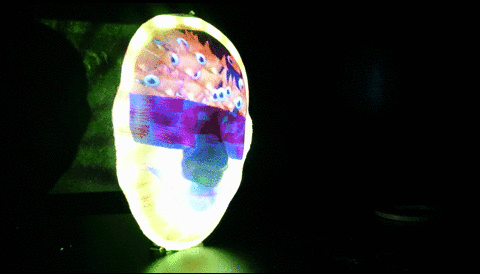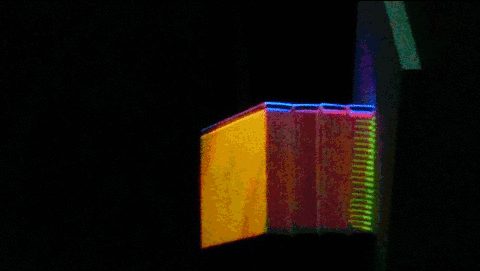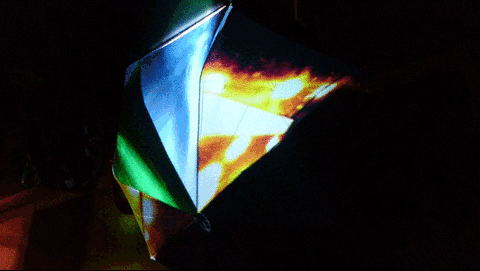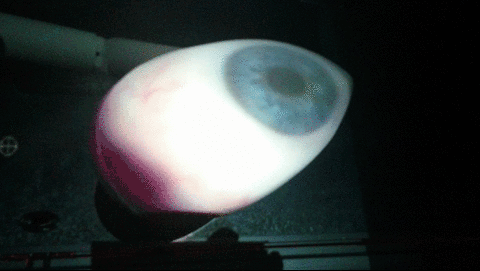I taught a 3-day workshop on Projection Mapping to a group of media design students at Shih Chien University’s Kaohsiung Campus. The goal of this workshop is to broaden their design horizon by learning something new and relevant to their background. According to my initial conversation with the program coordinator at FSDC, I learned that all the students have backgrounds in Illustration, Photography, Graphic Design, Motion Graphics, and have very little experience in programming. The first idea that came to my mind was Projection Mapping.
Other ideas were Littlebits or Makey Makey. I have used these two technologies extensively in my own teaching at Parsons. However, building interfaces with these two technologies lead to interaction and eventually software design. There is very little room, due to the technical hurdle, for this group of students to experiment after the workshop. I ditched the first idea and did brainstorming on their backgrounds. I drilled deeper into the common attributes and characteristics of those mediums. I found that “the presentation” of these mediums can be the focus of the workshop, and after some evaluations on available tools and software, I decided to run the workshop on Projection Mapping – a technology-less and code-less presentation method that can bring their works to life.
Workshop:
1. Design & Technology Lecture: This is an introduction to the design processes and theories of design & technology. It shows how design and technology go hand-in-hand and sparks innovations for each other throughout the history of arts and crafts in America. This lecture helps students understand their design education system and encourages them to explore new technologies, platforms, mediums for the growth of their own design/craft. The lecture also covers examples of various trends in New York including Bio Art, Internet of Things, Serious Game Design, Virtual Reality, Augmented Reality, Holograph, Fashion Tech, and Projection Mapping.
2. Projection Mapping: Also known as video mapping and spatial augmented reality, is a projection technology used to turn objects, often irregularly shaped, into a display surface for video projection. These objects may be complex industrial landscapes, such as buildings, small indoor objects or theatrical stages.
立體光雕: 也可以解讀成動態影像貼圖或空間式的擴增實境,是一種利用投影技術來將一個擁有不規則面的實體物件轉化成為一個可以投影的屏幕。一般來說,建築物的外牆、家具、生活雜物、表演的舞台、服裝和人的身體都是理想的立體光雕對象。
The way I designed this workshop is to have a lecture and design exercises in the morning and technical workshop and hands-on experiments in the afternoon. Contents wise I always over-prepared, that way I can skip certain contents or exercise according to the students in the workshop. I have prepared 2 design exercises for this workshop.
Design Exercises:
1.Irrational Forms: Participants are split into small groups of 4 or 5. Each group uses materials found in the environment to construct a tower as high as possible. Once all the tower is built, the facilitator will reveal the true purpose of the tower. Groups then deconstruct the tower into pieces and used them for the assigned purpose.
甚麼急轉彎: 參與者分成五隊,每一隊利用紙、筷子、麵條、剪刀、膠水與對型態和結構的了解來建一座紙塔。每座紙塔應該由多種材料所組成,越高越好,並發想一個固定的主題作為裝飾的基礎。每隊有一小時的時間建塔。
2.Art Machine: Participants are split into groups of eight and each group sit around a different table. Each participant takes a piece of paper and folds it into 4 rectangular cells on each side. Starting with the top cell, each participant writes down a descriptive sentence that includes at least a person, a place, and an activity. They have a minute to do so. When it’s done, pass the paper to their right. The next participant will create a drawing that best describe the written message. Alternating between writing and drawing and participants only allow to see the writing or drawing of the last participant.
越翻轉越美麗: 參與者分成八個人一隊。每隊每人拿一張影印紙並將其長邊對摺兩次成四等分,前後共八格。 由任一面的最上面一格開始,每人用一分鐘寫下一個句子。這個句子裡需要至少有一個人物、一個地點和一個動作。時間到後將紙傳給自己右手邊的人。接下來,在下一格裡把上一個人所寫的內容畫出來。時間到後,小心的將紙摺好所以下一個人只會看到自己的畫,傳向右手邊。下一個人再將畫再翻回文字。這樣一直重複直到八格都用完。集合分享!
Tools:
VPT 7: Conversation with Space
https://hcgilje.wordpress.com/vpt/
VPT (Video Projection Tool 影像投影工具) 是一個由 HC Gilje 設計的免費的多功能光雕軟體。適用於蘋果和微軟。 除了一般投影的合成外,VPT更可以用來將動態影像投影在複雜的物體表面上、整合預錄和即時的影片投射、多螢幕的HD高畫質播放、或者是使用在以微處理器(Arduino)或是攝像追蹤為主的互動裝置藝術。
Inspirations:
http://www.youtube.com/embed/KToDmJbEE7Y
http://www.youtube.com/embed/RVDUeG13AvM
http://www.youtube.com/embed/XSR0Xady02o
http://www.youtube.com/embed/EjzzgoJRlag
After Workshop:
The workshop went smoothly, I have so much fun working with all the students in the workshop! The survey on the first day shows a devise interest in digital and analogue media. Projection Mapping worked well as a strong visual output for all of them. I had each student brought an object to be projected on at the end of the second day. It could be anything as long as it has a non-flat surface. Most of the students used something from their backpack as the mapping object which felt unprepared and less creative. This might because the assignment/object was loosely defined and I did mention pencil boxes and notebooks as examples… However, there were fun objects beyond my imagination and the original video contents that some students brought were very well made.




The morning sessions were short, so I cut the design exercises out and focus on the lecture. I would like to run the design exercises next time tho, did feel like something was missing in brainstorming. Projection Mapping was a great topic for this group of students, everyone has a library of assets and videos they created for other courses and it is very easy to import them to VPT and project them onto an irregular surface which instantly upgrades the presentation of their work.
Hopefully, their Summer-long project will find that balance and make sense of the design and the technology. The home-brew cube surface demo was a success. It is very effective and portable. I made an interactive version of the original demo with Leapmotion, students lined up to try it which is awesome!
Students definitely loved the Oculus Rift Rollercoaster demo during the lunch break on the 2nd day. Broadening their horizon, checked!
This won’t happen without Ruei, Mars, and the program director’s assistance. Students were amazing at what they do and the mapping software was a cake for them. Hopefully, it opens up a new way of expressing their thoughts and works. Looking forward to collaborating more!